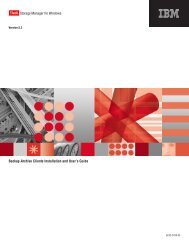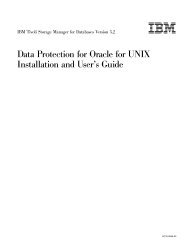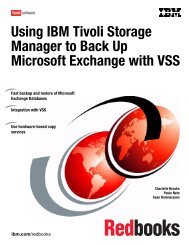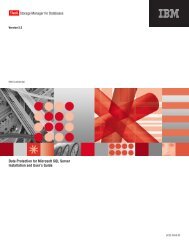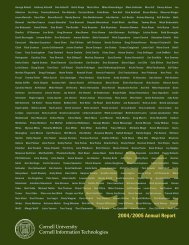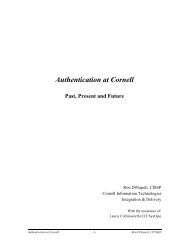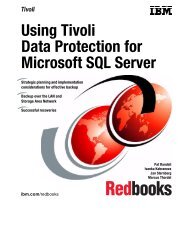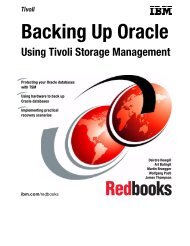Installation and User's Guide - Services and Support
Installation and User's Guide - Services and Support
Installation and User's Guide - Services and Support
Create successful ePaper yourself
Turn your PDF publications into a flip-book with our unique Google optimized e-Paper software.
IBM Confidentialwant to restore. The object name uniquely identifies each backup object<strong>and</strong> is created by Data Protection for Exchange.Use the Data Protection for Exchange query tsm comm<strong>and</strong> to view thenames of the backup objects.If the tdpexcc restore sgname incr comm<strong>and</strong> is entered (without the/object parameter) to restore multiple active incremental backups, allmultiple active incremental backups are restored sequentially. The /objectparameter is used to restore only one incremental backup at a time./PARTial=dbname1,dbnameNUse the /partial parameter to specify that only the named databases(dbname1,dbnameN) within the full or copy backup should be restored.Considerationsv If you specify this option, you must include at least one valid databasename.v If you do not specify this option, all databases within the backup arerestored.v You cannot specify this parameter while using VSS Instant Restore. Youmust restore ALL databases within the specified storage group whenperforming a VSS Instant Restore. Although Data Protection forExchange allows this operation to begin, it will either fail or completewith undesirable consequences. If you need to restore just one databasefrom a VSS Backup that resides on local VSS shadow volumes on DS orSAN Volume Controller disks, make sure to specify /instantrestore=noon the comm<strong>and</strong> line interface. If VSS Instant Restore capability isneeded for single databases, make sure to place these databases in theirown storage group./Quiet This parameter prevents status information from being displayed. Thisdoes not affect the level of information written to the activity log./RECOVER=APPLYRESToredlogs|APPLYALLlogsUse this parameter to specify whether or not you want to run recoveryafter you restore an object. It is recommended this parameter be specifiedon the last backup object restored for any particular storage group. Toinitiate recovery, you MUST use the /recover parameter when restoring thelast backup object of a storage group. In addition, the value of/templogrestorepath should not be the same value as the current locationfor the storage group. If the value is the same, corruption can occur.Failure to use the /recover parameter when restoring the last backup set ofa storage group leaves the databases unmountable. If this occurs, you caneither restore the last backup again <strong>and</strong> specify the /recover=value optionor you can use the Microsoft ESEUTIL /cc comm<strong>and</strong> to run recoverymanually.You MUST specify one of the following values when using this parameter:APPLYALLlogsSpecify /recover=applyalllogs to replay the restored transactionlog entries AND the current active transaction log entries. Anytransaction logs entries that appear in the current active transactionlog are replayed. This is the default.APPLYRESToredlogsSpecify /recover=applyrestoredlogs to replay ONLY the restoredtransaction log entries. The current active transaction log entrieswill NOT be replayed. When restoring a mailbox database to a92 Storage Manager for Mail 5.5: Data Protection for Microsoft Exchange Server <strong>Installation</strong> <strong>and</strong> User’s <strong>Guide</strong>



